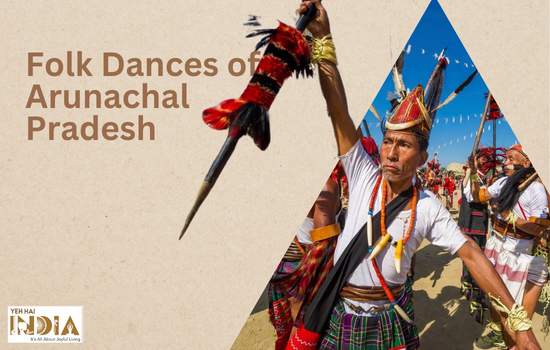Folk music has played a significant role in shaping cultural identity and preserving traditional values of a particular region.
Folk music in India is a rich and diverse genre that encompasses a variety of musical styles and traditions from different regions of the country.
Each state in India has its unique musical heritage and styles, with songs reflecting the local culture, language, and history. The lyrics often address social, political, or personal issues that are important to the community.
Folk music serves as a historical record of a community’s experiences and beliefs and has played a role in movements for social and political change.
It is deeply rooted in daily life and is often performed at festivals, religious ceremonies, and social events. It brings together people of all statures and is an integral part of India’s cultural heritage.
Some of the most well-known forms of Indian folk music include Bhavageete from Karnataka, Baul from West Bengal, and Qawwali from North India.
Folk Music During Communal Revolution

Folk music in India is a part of our celebrations as much as a means of political and social protest, with songs addressing issues such as poverty, inequality, and oppression.
Bhangra music of Punjabi farmers was traditionally performed to celebrate the harvest and has since evolved into a popular dance form. Lavani music of Maharashtra is performed to address social issues such as gender inequality and oppression.
Recommended Story – # Top 15 Famous Indian Musical Instruments Names with Description & Pictures
Popular Indian Folk Musical Instruments:
1. Harmonium

It is a manually-played keyboard instrument consisting of hand-pumped bellows to generate air, and metal reeds that are selectively opened and closed by pressing a set of keyboard keys.
The harmonium’s reed bank consists of several rows of metal reeds which produce two distinct tones for each key depressed – a main note and a higher harmonic note.
2. Sarangi

The sarangi is a bowed string instrument of the lute family that is widely used in the folk music of North India, Bangladesh and Nepal.
It is typically made out of a single block of hardwood that is hollowed out and fitted with three or four main playing strings and around thirty supporting strings.
Its strings can be tuned to various microtones, allowing for a range of expressive possibilities beyond the scope of other stringed instruments.
3. Tabla

Tabla is a percussion instrument borne out of thick cowhide. It is a pair of small hand drums consisting of a right-hand drum called ‘Dayan’ and a left-hand drum called ‘bayan’.
The ‘bayan’ is usually made of metal and the ‘Dayan’ is generally made of wood. It creates unique timbres and can be used to play highly intricate and complex rhythms.
4. Santoor
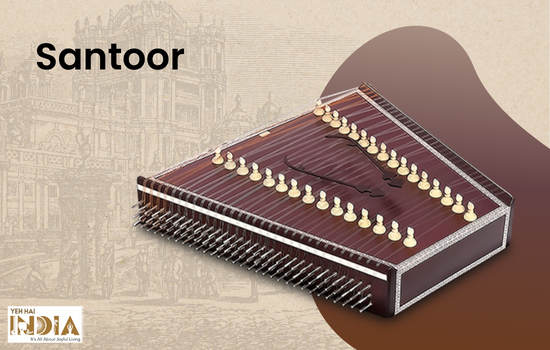
Santoor is a traditional folk string instrument, It is a trapezoidal-shaped box made of walnut or maple wood, ranging in size from 40 to 67 cm long.
The instrument has two sets of strings, one set of sympathetic strings, and two bridges that link together separate rows of strings.
It is usually played with a pair of flat wooden mallets, often called hammers or mizhars.
5. Dholak
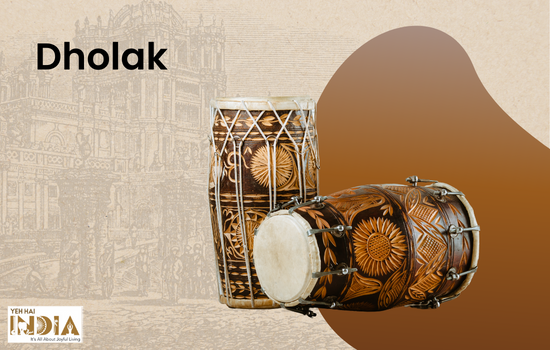
Dholak is a barrel-shaped two-headed drum made from teakwood, with the left head covered in parchment and the right head left open for greater resonance.
It has a distinct sound that combines bass and treble and plays complex rhythms that can range from traditional Indian music to modern, upbeat dance grooves.
While typically played with a pair of sticks, the dholak can also be played with hands or using special techniques.
6. Jal Tarang
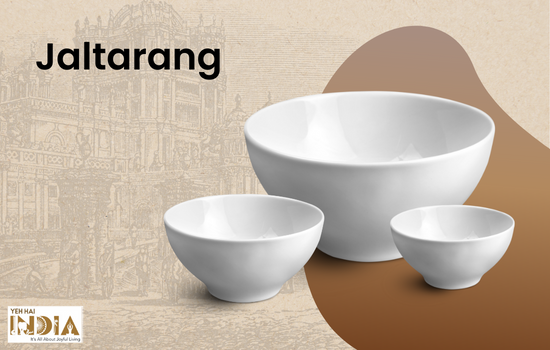
Jal Tarang is a traditional Indian percussion instrument consisting of a set of ceramic or metal bowls, filled with varying amounts of water to produce different pitches.
The musician strikes the edges or rim of the bowls with a pair of sticks to create rhythm and melodies.
7. Dotara

This two-stringed instrument is widely used in folk music from India and Bangladesh. It is a small lute instrument made from a single gourd or pot with a long handle, over which a fretless metal-string neck is attached.
It has four main strings and four to eight sympathetic strings. It has a large gourd for the body and is played with a small pick or the fingers.
The string tension on the instrument is high, and its deep, throbbing sound has captivated audiences for centuries.
8. Shahnai

The Shahnai is a double-reed North Indian folk instrument with a conical bore. It is similar to the oboe, although slightly larger and wider, making it one of the loudest folk instruments played today.
It has seven finger holes, of which the first five are usually in-line, while the remaining two are generally at the same level as each other. It is believed to bring good luck and prosperity at weddings and festivals and consists of a metal body with metal keys attached at one end.
Its deep and majestic sound is often used to provide the backdrop for other instruments in performance.
9. Parai
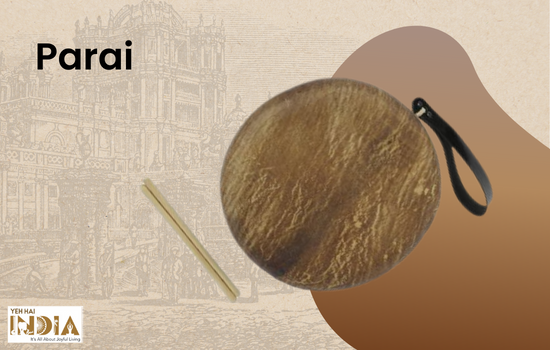
Parai is an ancient and traditional South Indian folk instrument made from a single piece of goatskin. The drum is slung across the shoulders of the player and is usually played with sticks.
The drum has a characteristically deep and powerful sound, and it is often used as an accompaniment to folk songs and other genres of folk music, especially in rural areas. As the instrument is handcrafted, each piece is unique, and the size and shape of the drum may vary.
There is a belief that this instrument is the earliest predecessor of the modern-day drum set, as it is composed of various sizes and depths of drums.
10. Pungi

Pungi is made from a hollow bamboo tube. It is a double-reed wind instrument renowned for its shrill and enthralling sound.
It is usually played by snake charmers and other street performers and is played by using the hands to manipulate two pieces of cane attached to the bamboo tube at either end.
The sound it produces is created by the breath being blown into the pipe and the oscillations of the cane creating a buzzing sound.
Get to know India’s thriving folk music culture with these specially crafted instruments that create a thrilling and soothing music.
Also Read – Classification of Classical Indian Musical Instruments






